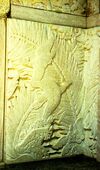| Wrigley Botanical Gardens | |
|---|---|
 A tree at the gardens | |
| Geography | |
| Type |
botanical garden and memorial |
| Location | |
| Coordinates | |
| Size |
38 acres |
| Specimens | |
| Collections |
plants endemic to the Channel Islands of California |
| History | |
| Economic information | |
| Operated by | |
| Status |
Open daily, 8 am to 5 pm |
| Website | |
The Wrigley Memorial & Botanic Garden is a botanic garden found on the Santa Catalina Island in California that is operated by Catalina Island Conservancy. Though it is mainly a garden, it contains a memorial to William Wrigley, Jr.
History[]
The botanical garden was first suggested in 1935 by Ada, William Wrigley, Jr.'s spouse. Ada oversaw the work of Albert Conrad, a horticulturist from Pasadena, who originally planted the desert plants in the garden.
Garden[]
The garden covers 38 acres (154,000 m²) near Avalon on Catalina, off the shore from Los Angeles. It places a special emphasis on endemic plants of the California islands, which are plants grown naturally on atleast one of the Channel Islands of California and nowhere else in the world.
Special emphasis is placed on six endemic plants to Santa Catalina: the Catalina Ironwood (Lyonothamnus floribundus ssp. floribundus), the Catalina Mahagony (Cercocarpus traskiae), St. Catherine's lace (Eriogonum giganteum var. giganteum), Dudleya virens ssp. hassei, Arctostaphylos catalinae, and Galium catalinense ssp. catalinense.
Wrigley Memorial[]

Part of the Wrigley Memorial.
William Wrigley, Jr. (1861-1932) bought most of Catalina Island in 1919 with the proceeds from chewing gum franchise. When Wrigley died on January 26, 1932, at 70 years old, he was interred near his home on Catalina, in a tower in the botanical gardens. This tower stands 130 ft tall and is mainly built with local materials. Wrigley's body has been moved since, but his original grave marker still adorns the tower site.